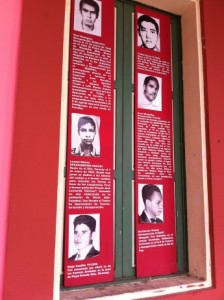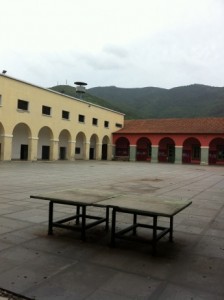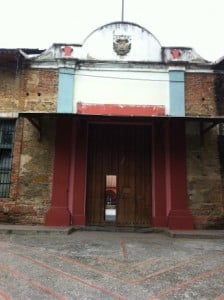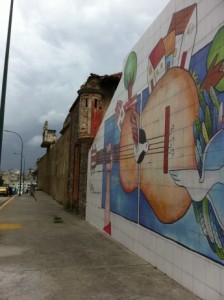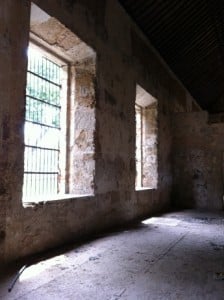Venezuela’s “Political Prisoner” Allegory
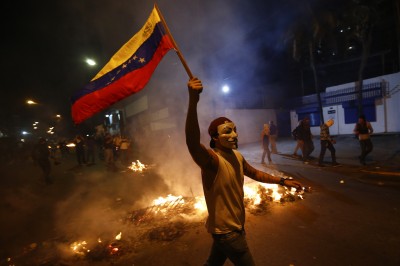
In the face of arrests, trials, and detentions of opposition and student leaders, allegations of political repression in Venezuela are circulating international and private national press. The Venezuelan government and its supporters adamantly reject the claim that Venezuela has any political prisoners and they assert that everyone in detention is being tried for their involvement in criminal conduct. This article aims to explore the issue of political prisoners in Venezuela by providing a broader historical context combined with an analysis of power in Venezuela today.
“Freedom for Political Prisoners” is spray-painted throughout wealthy neighborhoods in Caracas. The right-wing opposition has claimed that their leader, jailed politician Leopoldo Lopez was imprisoned for his beliefs. A recent New York Times editorial also claims that there is a “crackdown on opposition” in Venezuela, an accusation echoed by much of the private press in Venezuela, representatives of the government of the United States and the Venezuelan right-wing political opposition.
Even many progressives outside of the country who support the struggle for self-determination and redistribution in Venezuela, have been growing wary of the ongoing reports of arrests of students and protesters following the months of guarimba protests: the violent street barricades implemented by some anti-government demonstrators which caused the deaths of many of the over 40 people who died during that period of unrest.
Photos of political prisoners detained at San Carlos between 1960-1979, on a wall of the former prison in an exhibit maintained by a civic association of former combatants and political prisoners. (all photos credt of Venezuelanalysis.com / Cory Fischer – Hoffman)
As the political climate in Venezuela becomes increasingly polarized, and the media continues to push an anti-government agenda, it is increasingly difficult to know where to turn for information, who to trust, and quite frankly, how to make sense of the arrests, detentions, and trials of opposition leaders.
By exploring the historical context of political prisoners in Venezuela and what that phrase has meant in the country’s recent history, it is easy to see why there is controversy over its use today and what distinguishes today’s “political prisoners” with those of past generations.
Memories of the Not-So-Distant Past
Venezuelans are not unfamiliar with the concept of a political prisoner but for most Venezuelans, Harvard-educated opposition leader Leopoldo Lopez, dressed in a clean suit, is not the image that comes to mind.
The San Carlos Military Barracks in Caracas, built in 1771, were transformed during president Guzman Blanco’s era of “order and progress” (1870-1887) into a prison which would be used to hold political prisoners until the 1990’s.
Under the dictatorships of Juan Vicente Gomez (1908-1935), Marcos Perez Jimenez (1948-1958), and the “democratic” era known as the 4th Republic (1959-1998), San Carlos prison was notorious; as a locale of torture and detention of dissidents. Hugo Chavez himself was detained there following his failed coup attempt in 1992.
The courtyard of the former San Carlos prison, very different from how it looked when it was home to hundreds of political dissidents. Afro-Venezuelan abolitionist and independence leader was murdered in that courtyard on December 10, 1796.
As I approached the enormous building, it was hard to tell where the entrance was. Despite a crumbling facade, the building appeared to be sealed off and just looking at it made me wonder what was going on inside. Once I found the entrance, I was escorted by a watchman to the creaky wooden door, and he opened a huge iron bar gate to bring me to the offices upstairs.
Today, San Carlos is being preserved by an association of former combatants who participated in the guerrilla struggle in Venezuela in the 1960’s-1970’s; many of whom were imprisoned and tortured in that very building. Their goal is to preserve the structure, share their stories and make sure that the human rights abuses that took place at San Carlos never happen again.
I knocked on the office door and found Enrique Velazquez, affectionately known as “Negro Miguel,” finishing up the last bites of his lunch. He told me to wander around the building and that he would be down to give me a tour shortly. I poked my head into cavernous dusty rooms and looked out the iron bars, wondering how many people had seen Caracas from that perspective. Velazquez found me in the back room, and invited me to tour the building. As we walked around, I interviewed him about his ten years as a political prisoner under the Betancourt, Leoni and Caldera regimes, one of those long years in captivity was served at San Carlos.
He took me into dusty chambers and shared memories of comrades that he had lost in that building. He rolled up his sleeves and showed me scars on his arms from cigarette burns and pointed to a wall where a friend of his had written “Down with Rómulo” (President Betancort), an action which cost him his life.
Former political prisoner Enrique Velasquez, known affectionately as “Negro Miguel”spent one of his ten years imprisoned in San Carlos. He now leads tours to preserve the memory of their fallen comrades.
Velasquez invited me to come and look at the photos on the wall of the numerous killed and disappeared during this era. “This guy,” he said, pointing to a photo, “was from La Pastora,” [the neighborhood where San Carlos is located] and, just a few blocks from his home, he was killed here.” He seemed to personally know almost every person whose picture we passed and I was fascinated that he chose to spend his time in a building where he had experienced such cruelty and trauma and where he had lost so many friends and comrades. While Velasquez was imprisoned in an era that was labeled as “democratic,” his stories of torture are strikingly similar to those who were held captive under previous dictatorships.
In 1928, after massive student strikes, a whole generation of youth were rounded up and placed into Gomez’s prisons in Venezuela. While in prison, generation ’28 (as the students were called) continued to organize against Gomez and successfully spread socialist ideas throughout prisons in Venezuela by organizing conferences and circulating documents among the prison population. Their success at organizing led the government to isolate “political prisoners” from “common delinquents” so that the radical ideas of the political prisoners would not spread to the general prison population. The isolation also helped reserve the most gruesome forms of torture for the political prisoners alone.
Under the dictatorship of Perez-Jimenez (1948-1958) members of the Communist Party and the political party Democratic Action (AD) were rounded up by the secret police, and taken to concentration camps on Guasina island on the Orinoco river and the Isla del Burro on Valencia Lake.
Because many of the political dissidents came from the literate working and middle classes, their testimonies of torture were recorded and some have been published and circulated in Venezuela. This vast collection of 20th century political prisoner testimony actually constitutes its own genre of literature within Venezuela. Reported methods of torture included cigarette burns, being forced to sit on blocks of ice, the force-feeding of laxatives and being cut with razors.
The entrance to San Carlos, with some of its features dating back to its construction in 1771.
A consistent thread throughout these testimonies is that all of these political prisoners shared a common enemy: a small political elite that exercised their power over the government to personally enrich themselves at the exclusion of the majority. Despite varying political currents and tactics among these groups as well as distinct historical contexts, they were all fighting for social justice and greater wealth sharing in resource-rich Venezuela. This is what Velasquez called “a moral and ethical condition,” which he described as a fundamental characteristic of all political prisoners.
What’s what today
It is necessary to make some distinctions between the political prisoners of the past and those who claim to be such in the present day.
The broad umbrella of those whom the opposition consider to be political prisoners fit into these three categories; 1) officials (largely police officers) who have been tried, found guilty and sentenced for their participation in the 2002 massacre and coup attempt against Chavez which left 29 people dead and hundreds injured; 2) Politicians and student leaders who are being accused of inciting violence during the isolated guarimba protests from February to May of this year, which resulted in 41 deaths, including nine deaths of security forces 3) Those who have been detained and brought in for questioning due to suspicions over their involvement in the trafficking of contraband (basic goods that should be sold with adherence to strict price controls but, are instead being sold in an informal and speculative market in Venezuela or trafficked across the Colombian border for a profit.) Additionally, there are members of the political class such as Judge María Lourdes Afiuni, who was sentenced after allowing a businessman convicted on corruption charges to exit her courtroom in order to flee the country.
A newer mural painted next to the ancient San Carlos former prison.
The recent release of Iván Simonovis, the highest-ranking of police officials to be found guilty of assisting the 2002 coup, has invoked outrage from the association made up of the families of those who fell victim that fateful April day. Simonovis was recently granted release to house arrest due to health problems, after serving 10 years of his 30-year sentence in prison. Police Commissioners Henry Vivas and Lázaro Forero are still in prison, serving their 30 years sentence. Of the seven other officers convicted for their involvement, many were given lesser sentences and have since been released. Pedro Carmona, the coup leader who temporarily installed himself as president and dissolved all democratic institutions, was placed on house arrest but he escaped to Colombia via the Colombian Embassy, where he now lives comfortably as a university professor.
Prior to his detention, Simonovis had worked with the Bratton Group, a US based security consultant that is notorious for its “zero-tolerance” policing and exporting the New York City model of targeting of poor people of color and increasing rates of incarceration. In a 2008 opinion article authored by William Andrews, then police and security consultant with the Bratton group, he takes jabs at President Chávez and offers promise for the budding “37-year-old Harvard-educated, reform-minded mayor of Caracas’s Chacao district;” none other than currently jailed opposition leader Leopoldo López. The Bratton Group representative admits to meeting with López and to being “impressed by his intelligence, energy, and insight.”
Six years later, Leopoldo López is the poster child for right-wing claims of political repression and the current heir of the opposition movement, displacing Henrique Capriles who claimed to be the victim of electoral fraud after losing in two consecutive presidential elections in 2012 and 2013 against Chavez and Maduro, respectively. Leopoldo López called for massive street action to force the “exit” or resignation of president Maduro, mobilizing primarily upper class Venezuelans who had long opposed the socialist government and encouraging them to take to the streets in what was later portrayed as a “student movement.”
Inside the former San Carlos Prison.
Also facing trial are two Venezuelan youth, Lorent Saleh and Gabriel Valles. Recently leaked videos showing them plotting destruction. “We´re going to administer a huge blow, pow, on the same day… one at an insurance company, another in a parking lot where the trucks that they use to transport oil are held, one, which is emblematic, a political headquarters of the local government and a bank,” Saleh stated on the video recording of a skype call . He also claimed they had spent over $8,000 USD on explosives, which implicates a broader and more resourced network of financial backers for their plans.
Saleh and Valles now both face trials for six criminal charges, some of which date back to violent protests that they were involved in prior to the guarimba. The video evidence does not bode well for their release.
Daniel Ceballos y Enzo Scarano, Mayors of San Cristobál and San Diego, respectively, have also been arrested and are facing criminal charges for their involvement in the violence. Scarano was jailed due to the his failure to comply with a Supreme Court ruling ordering him to take down street barricades during the guarimba in the area under his jurisdiction. Ceballos was arrested on similar grounds but is additionally being investigated for charges of rebellion and conspiracy.
From May to June on 2014, an estimated 200-300 students and opposition leaders were arrested in response to the protests. Almost all of those studentswere released shortly thereafter but Ángel González, Marco Coello, Demian Martín and Christian Holdakc, leaders associated with Leopoldo Lopez’s political grouping have been in pretrial detention for over seven months and still have not begun their trial. This is consistent with slow pacing of criminal proceedings in Venezuela, which is why just over half of the nearly 50,000 people incarcerated in prisons and jails throughout the country have yet to be sentenced.
While the opposition protests were most certainly not just a response to high inflation rates as claimed, the video evidence of Saleh talking about explosives and “social cleansing” demonstrate deeper political motives to overthrow the Venezuelan government (and do a lot of damage in the meantime).
“Freedom for Political Prisoners” spray-painted on a wall in the wealthy neighborhood of Chacaito.
Opposition supporters are not the only ones concerned with the difficult economic situation in Venezuela, and as the root causes of the crisis become clearer (speculation, hoarding, trafficking of goods, corruption, mismanagement, sabotage by the business class as a form of organized protest to price controls, and a significantly overvalued exchange rate accompanied by a significantly undervalued informal market rate for dollars), the Maduro government is under a lot of pressure to take action, which has led to numerous arrests of people suspected in trafficking contraband across the border and other related crimes.
This recent wave of arrests is likely to sweep up innocent people in the process and I have personally spoken to a number of Venezuelans who resent the arrests of working people making a buck through selling cooking oil at higher prices when very few National Guards members, who are presumably involved in the very profitable trafficking operations on the Colombian border, have been arrested. I spoke to someone last week who has a family member in prison at Tocorón, because he didn’t have the correct papers for the delivery that he was making and therefore was accused of smuggling goods. And, in a case that will hopefully be released shortly, long time community leader and organizer Johnny Moreno was arrested along with Hernan Marín Pérez who were working as government officials on the front line in the fight against corruption during the economic war.
While some of these arrests are indeed troubling, so is the economic reality in Venezuela, though it’s too early to tell if the government will actually go after the big fishes, or similar to the war on drugs, round up the lowly dealers while catching innocent people in its net in attempts to stabilize the economy. But, despite this concern, people within this category are not a part of any unified political force and could hardly be considered political prisoners; if anything this war on contraband runs the risk of looking more like a war on drugs, as mentioned above.
However none of these arrests have raised an eyebrow with the political opposition, who are more preoccupied with the recent 24 hour detention and questioning of Eduardo Garmendia, president of the Confederation of Venezuelan Industries (Coindustria).
Those championed by the opposition who have been called in for questioning or are in pre-trial detention- are not only a part of the “political opposition” but, they are members of the economic elite, not the disenfranchised. While most of Venezuela’s prison population is comprised of poor folks who are often racialized or discriminated for their poor or rural background; this relatively small group of incarcerated politicians and professionals is a total anomaly among the prison population. In the past, members of this class simply did not go to prison, regardless of the level of their crimes.
This is, in part, why the elite are so infuriated; they expect to be above the law.
The opposition leader detainees are being painted as political prisoners largely because they come from the upper classes and it is therefore assumed that they do not belong in prison. I am not saying that wealthy people cannot be political prisoners; but as opposed to past generations of political prisoners (some of whom came from privileged households) these politicians and militant youth are not fighting against the concentration of power in the hands of the economic elite; they themselves, are the economic elite or are at least fighting for their interests.
The political process that has been underway in Venezuela since the popular uprisings in response to neo-liberal restructuring in 1989, and formally placed into motion with the election of Hugo Chavez in 1998 has, in broad terms, been about creating mechanisms of wealth-sharing so that the poor majorities can live dignified lives. The threat of transforming the country in such a way has brought out some of the ugliest, most anti-democratic, and racist sides of the right-wing elite in their greed to control all of the countries resources coupled with their absolute contempt for the poor. Needless to say, it has won them very little sympathy from the country’s majorities.
Contested Space
When I asked former political prisoner, Velasquez if political prisoners existed in Venezuela today, he smiled and I could tell that, to him, the question was loaded with ironies.
After reminding me of the gruesome torture that he had experienced he said, “I spent three years in the guerrilla. and where did we go to fight? We went to the mountains, We didn’t go into a supermarkets, we didn’t prevent people from getting medicine for their loved ones, we didn’t burn metro cars, like in theguarimba- when so many people died during those days….So, if this is political, trying to make it so that the people don’t eat…Is this a political prisoner? Or, is this banditry?” he looked at me, and clearly wanted me to answer the question but, I just nodded my head.
Velasquez told me that in his lifetime he had fought against 9 consecutive governments, so he was no stranger to opposing the regime. “Listen,” he said, “if they want to fight the government, well, fine, continue fighting the government, but why fight me and my family?
Velasquez encouraged me to talk to the muchachos, the young people detained, and ask them what their cause was and if I have the opportunity, I surely will. For him, and for many Venezuelans, using the term “political prisoners” to describe the leaders of a right-wing elite that control large portions of the media, basic goods, imports, and land and whom have been involved in violence and sabotage resulting in widespread harm, is an insult to a label that he carries with pride, and under which many of his comrades were killed and tortured.
Conclusions
A joke among popular classes is that there are no political prisoners in Venezuela, just imprisoned politicians. Some people, like Velasquez, do not believe that the privileged politicians and leaders of right-wing organizations deserve such a noble title and many see their incarceration as a testament that, finally, they are not above the law.
Nonetheless, these politicians and students are mostly incarcerated at the Ramo Verde Military prison in Los Teques, and they have far better access to lawyers, medical attention, and basic services than the average person in prison in Venezuela. Their complaints of human rights violations, crumbling infrastructure, and inhumane treatment should be addressed but they must be seen as relative to the notoriously poor conditions in prisons throughout the country- and therefore be addressed on a national level.
Based on Venezuela’s long history of gruesome torture of youth and political dissidents, the imprisonment, murder and disappearance of thousands of people during past regimes, the trials of opposition politicians and student leaders directly tied to actions that resulted in the deaths of civilians can hardly compare.
The recent war on contraband is worth monitoring and while there is widespread support for government actions being taken against the smuggling of goods, it is possible that innocent people or low-level traffickers will be the ones who end up serving time, instead of those who are running operations or making huge profits off of the trafficking of basic goods.
But the political opposition is not concerned with innocent people in prisons in Venezuela, nor are they concerned with the consistently slow criminal proceedings and poor conditions in Venezuela’s prisons; their concerns are limited to their own elite circles and to the relatively few members of the political opposition who have formerly been charged with crimes and who seem to be facing lengthy prison sentences as a result of their involvement in actions that have had extremely damaging consequences.
Nonetheless, the government and its supporters’ justification of the arrests of opposition leaders on the account of their “criminality” could serve to fuel the tough on crime approach that disproportionately harms the poor, and more so those with darker skin. The criminal-baiting rhetoric also fails to provide adequate context to progressives around the globe who are wary of the increased levels of criminalization and incarceration in their own countries, and can seldom push past the inundation of anti-government media to understand the broader context in Venezuela.
The economic problems in Venezuela today are linked to the political turmoil in the country last spring, and in the coming months the trials of jailed politicians, right-wing opposition leaders, students, and alleged smugglers may bring some of these connections to light.


